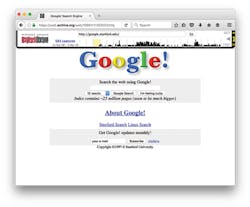Time travel is possible
Keeping your dental practice website up to date is key to attracting new patients. In this article, Kevin Rach explains how websites have evolved over the years. How does yours measure up?
Time travel is possible. You can even do it in the comfort of your own home. You don't need a DeLorean, a flux capacitor, or 1.21 gigawatts of anything. All you need is an Internet connection, a web browser, and a little free time (oddly enough).
Enter the Wayback Machine, the Internet archive located at archive.org. Inside, you can travel through the ages of the Internet, exploring the websites of yesteryear. It might not have gull-wing doors, but when you step inside, you can't help but be struck by how much things have changed in such a short amount of time.
If you were practicing in the mid to late '90s, you probably didn't have a website for your practice unless you were exceptionally forward-thinking. Practice websites simply weren't necessary. Now, websites are a must-have for all but the most established practices. And if your website looks anything like what you'll see in the Wayback Machine, you might have a problem.
With that in mind, let's take a trip back in time to see what separates old sites from the successful practice websites of today.
The big bang: HTML (1990)
There can be no websites without HTML (hypertext markup language). The first public website, Cern's 1991 World Wide Web directory, contained only HTML. It's nothing compared to today's sites, but it's the foundation of all web design. Your practice website must contain HTML.
The first public website contained only HTML, the foundation of all web design.
The first signs of life: CSS (1994, widely implemented circa 1997)
CSS (Cascading Style Sheets), explained simply, is what makes a website look good. CSS allows you to add colors, layouts, fonts, and other enhancements to the bare bones of HTML. Without it, every website would look like Cern's. We have early CSS to thank for the New York Times website in 1996, Google in 1998, and more. Thankfully, CSS has been thoroughly developed, and more advanced forms of it are still widely used today. Your website almost certainly uses a form of CSS.
Introduced in the '90s, CSS offered options for enhancing website design beyond basic HTML.
The dinosaurs: Flash (1996, widely implemented circa 2000)
In its heyday, Flash allowed information and design to live in harmony. It added style to the web, allowing sites to use animation.i Back then, Flash was both necessary and cool. Now, it's the opposite. Flash includes easily exploitable security vulnerabilities, and when used incorrectly, it can tank a website's Google ranking. We now have better options. If your website uses Flash, it's time for an upgrade.
The renaissance: Mobile (2007)
The birth of the iPhone changed the web forever by putting a computer in everyone's pocket. Sadly, desktop-sized sites don't fit on pocket-sized screens. The first mobile sites adapted to the new world by redirecting iPhone users to another site, an exact duplicate, designed for mobile displays. It was a simple solution and the standard for many years. Nowadays, an old-school mobile site creates long wait times and can harm your Google ranking, thus failing to capture new patients.
The modern era: Responsive design (circa 2010)
Today, through tricks of CSS and HTML5, one responsive website can fit any device. They load faster than mobile sites, deliver better Google results, and represent the gold standard in modern web design. Many practice websites, especially those built before 2012 or so, are not responsive. If you want to reach the most possible patients, make sure yours is responsive.
Author's note: If you need to talk to an expert about your website, or if you're simply not sure where you stand, contact one of Officite's web presence advisors for a personalized website consultation. Call us at (877) 786-7511 or visit officite.com/dental. We'll help you get your website back to the future.
Note
i. For an example of Flash animation, visit nrg.be/archived.
Kevin Rach is the communications manager at Officite, a leading provider of websites and online marketing in the dental industry. He and his team produce content designed to help dentists thrive in the online marketplace. For more information, visit officite.com/dental, or like Officite on Facebook.




